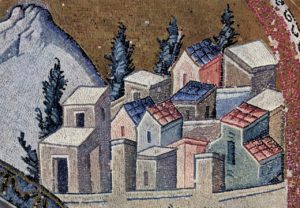N.B.: I am in the Holy Land at this time. As my travel schedule is heavy, I am republishing some articles about life in Jesus’ day. I hope you will enjoy reading (or re-reading) them as much as I did.
 The Jews of Galilee, where Jesus grew up, were essentially a rural people. The great majority lived in the many small towns and villages scattered throughout the countryside. They worked the land, tended their flocks, and plied their trades, seldom venturing more than a day’s journey from home. However, many went to Jerusalem, some as often as every year, to celebrate the Passover. And that was no small journey, up to 70 miles on foot each way!
The Jews of Galilee, where Jesus grew up, were essentially a rural people. The great majority lived in the many small towns and villages scattered throughout the countryside. They worked the land, tended their flocks, and plied their trades, seldom venturing more than a day’s journey from home. However, many went to Jerusalem, some as often as every year, to celebrate the Passover. And that was no small journey, up to 70 miles on foot each way!
According to Josephus, a Jewish historian of the time, there were 240 villages scattered throughout Galilee. The average village might be no more than a few acres with a population of a few hundred souls. (Larger villages called towns might cover ten acres or more and were often walled in.)
The world was pretty much limited to their small village and the fields around it. The inhabitants lived in modest one-story houses of stone covered with a kind of stucco.
The houses tended to be clustered around a town square. In the square were some shops, an open air market, and usually a communal well or spring.
Each town had a handful of local craftsman, typically including a potter, a weaver, a carpenter, a blacksmith, and a shoemaker. Most of the men in the village, however, worked in the fields, whether tilling, sowing, pruning, or harvesting. Life was a long, difficult struggle against the elements.
Most families kept a small number of animals such as sheep and goats. These were useful for milk, wool, and eventually leather and food. Most villages also had a shepherd or two tending village flocks on the nearby hillsides.
On many evenings the men gathered in the village synagogue for evening services and Scripture study. During the day the synagogue served as a school for the young men of the village, who learned ancient Hebrew and studied the Scriptures. Most people no longer spoke Hebrew; it was a sacred language used only in the Temple and in the synagogue, similar to Latin for the Catholic Church. Most villagers spoke Aramaic, but they also knew some Greek because it was the native tongue of the pagans around them. The Jews of Galilee spoke with a distinctive accent.
Villages were often in well-protected locations. They were generally built on hilltops rather than in the long sloping valleys. Here they were more easily protected and the best land in the valleys was reserved for agriculture.
The streets were generally quite narrow, more like alleys. The homes that fronted the streets came right up to the edge of the street. The walls of homes tended to be at least ten feet high, with only a few windows at the top. This is because one generally entered a home by walking into an open courtyard off the street. Whereas we tend to have front yards today, homes at this time tended to have courtyards, around which were clustered rooms of varying size depending on the wealth and needs of the owner.
Villages tended to be small because of the needs of each village were associated with pastureland around it. Each village depended on both crops and the livestock that used the surrounding fields and the sloping valley beneath. Further, each village was either built around or near a well or spring.
Each village tended to be self-sustaining in terms of basic needs. Occasionally, people would come from larger towns to provide specialized services, but except for a yearly pilgrimage, most Galileans did not travel far from their village.
Galilean villages were rather distinct from the Greek cities of the Decapolis, which were built in classical Greek style and tended to be much larger and more cosmopolitan. In a certain sense, the villages of Galilee were a world apart from the cities of the Decapolis.
Nazareth was a fairly typical Galilean village. It was laid out on a steep hillside and at the time of Jesus probably had no more than 300 residents. It was so unremarkable that Nathaniel asked “Can anything good come out of Nazareth?” (John 1:46) Today Nazareth has some 60,000 residents, mostly Arab Muslims, with a smaller number of Arab Christians. Its streets are steep, almost reminiscent of San Francisco.
Here’s a video I put together about the villages of Jesus’ day, with numerous pictures to illustrate:

